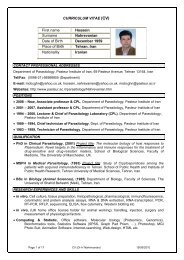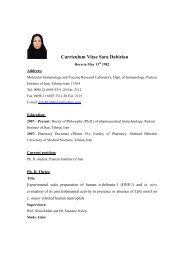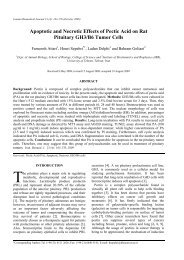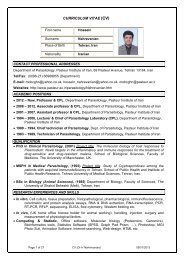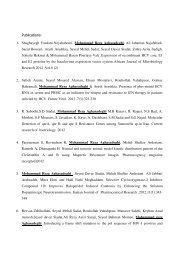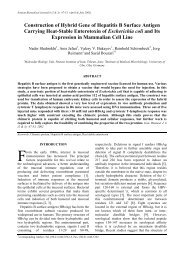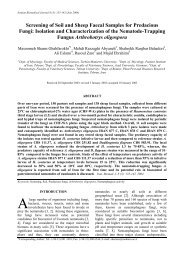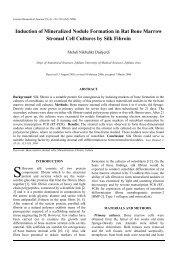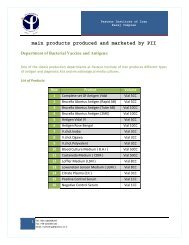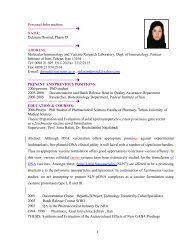Study of the Binding of Iron and Indium to Human Serum Apo ...
Study of the Binding of Iron and Indium to Human Serum Apo ...
Study of the Binding of Iron and Indium to Human Serum Apo ...
You also want an ePaper? Increase the reach of your titles
YUMPU automatically turns print PDFs into web optimized ePapers that Google loves.
Moshtaghie & GhaffariIn order <strong>to</strong> confirm <strong>the</strong> binding <strong>of</strong> iron <strong>and</strong>/orindium <strong>to</strong> apo-tf, equilibrium dialysis technique wasused (Fig. 4A). The binding <strong>of</strong> iron <strong>to</strong> apo-tf <strong>and</strong><strong>the</strong> effect <strong>of</strong> indium on <strong>the</strong> binding activitypresented in Figure 4A. In <strong>the</strong> presence <strong>of</strong> indium asa complex with citric acid, approximately 37%reduction in iron binding <strong>to</strong> apo-tf was seen (Fig.4A). Using Scatchard plot analysis <strong>and</strong> <strong>the</strong> data inFigure 4A, <strong>the</strong> binding constant for iron binding <strong>to</strong>apo-tf in <strong>the</strong> absence <strong>of</strong> indium was calculated (Fig.4B). The approximate binding constant for irontransferrincomplex was 8.7 × 10 6 M -1 (Fig. 4B).[ Fe+3 ] bound ( g/dl )[Fe+3] Bound/[Fe+3] Free140120100806040205432100A0 5 10 15 20 25 30By = -0.1144 x + 4.2957[ Fe+3 ] added (µ g )- In+ In0 5 10 15 20 25 30 35 40[Fe+3] Bound (µ mol/L)Fig. 4. The study binding <strong>of</strong> iron <strong>to</strong> apo-tf in <strong>the</strong> absence <strong>and</strong><strong>the</strong> presence <strong>of</strong> indium by equilibrium dialysis (A) <strong>and</strong>Scatchard plot for <strong>the</strong> binding constant <strong>of</strong> iron <strong>to</strong> apo-tf (B).Each point is <strong>the</strong> mean three experiments. ([<strong>Apo</strong>-tf] = 21.5 µMpH 7.4, t = 0-4°C).) .76DISCUSSIONPrevious reports suggest that due <strong>to</strong> biochemicalsimilarities <strong>of</strong> few cations with iron, <strong>the</strong>y mayinterfere with iron metabolism <strong>and</strong> cause somedisorders [7, 13]. Among <strong>the</strong>m are aluminum <strong>and</strong>chromium that could bind <strong>to</strong> serum transferrin <strong>and</strong>cause hypochromic microcytic anemia. In thisstudy, we used spectropho<strong>to</strong>metry technique <strong>to</strong>investigate <strong>the</strong> iron binding <strong>to</strong> serum apo-tf <strong>and</strong> <strong>the</strong>influence <strong>of</strong> indium in <strong>the</strong> binding activity.Absorption spectra obtained from iron <strong>and</strong>/orindium-transferrin complexes indicated twomaximum absorbencies at 465 <strong>and</strong> 255 nm,respectively. According <strong>to</strong> <strong>the</strong> previous reports, <strong>the</strong>maximum absorbance for iron-transferrin complexis 465 nm [10] <strong>and</strong>/or 470 nm [14-15] <strong>and</strong> forindium-transferrin complex is 250 nm [16] <strong>and</strong>/or245 nm [17], which is comparable <strong>to</strong> our findings .When <strong>the</strong> effect <strong>of</strong> pH on <strong>the</strong> binding <strong>of</strong> iron <strong>and</strong>indium <strong>to</strong> apo-tf was studied, it was found that <strong>the</strong>optimal binding activity <strong>of</strong> <strong>the</strong>se two metalsoccurred at pH 7.4. When pH was decreased <strong>to</strong>acidic pH, release <strong>of</strong> <strong>the</strong>se two ions from transferrinoccurred. The release <strong>of</strong> indium was more than iron.This might be due <strong>to</strong> <strong>the</strong> affinity <strong>of</strong> indium <strong>to</strong> -opatf, which is less tightly than iron. The observations<strong>of</strong> Lastas [18] <strong>and</strong> Ponka [19] are in agreement withour results binding <strong>of</strong> iron <strong>and</strong> indium <strong>to</strong> apo-tf arehigher at alkaline pH (pH 7.4) that at acidic pH. Thereduction in iron up-take by indium <strong>and</strong> vice versa,<strong>and</strong> <strong>the</strong> competition <strong>of</strong> iron with indium on <strong>the</strong>o<strong>the</strong>r h<strong>and</strong> suggest that <strong>the</strong>se two metal ions maycompete for <strong>the</strong> same binding site on <strong>the</strong> apo-tf.The same results were obtained when o<strong>the</strong>r trivalentelements were added <strong>to</strong> <strong>the</strong> human apo-tf [8, 15,17]. These competitive binding activities were alsoverified by equilibrium dialysis. In <strong>the</strong> indiumoutside <strong>of</strong> <strong>the</strong> dialysis sac, reduced binding <strong>of</strong> iron<strong>to</strong> apo-tf about 37%. Using this technique <strong>and</strong>Scatchard plot it was found that <strong>the</strong> bindingconstant for iron <strong>to</strong> apo-tf was 8.7 × 10 6M -1 . The difference between obtained bindingconstant for iron <strong>to</strong> apo-tf could be due <strong>to</strong> <strong>the</strong>discrepancies in <strong>the</strong> methods <strong>of</strong> binding <strong>and</strong> <strong>the</strong>fac<strong>to</strong>rs such as composition <strong>of</strong> buffer etc. Overall,it seems that both iron <strong>and</strong> indium bind <strong>to</strong> <strong>and</strong>complete for <strong>the</strong> same sites <strong>of</strong> transferrin. Theoccurrence <strong>of</strong> microcytic anemia in patients withindium overload may, however, be due <strong>to</strong> <strong>the</strong>competition <strong>of</strong> indium with iron in iron metabolism.More investigations should be done <strong>to</strong> elucidate <strong>the</strong>exact mechanism <strong>of</strong> <strong>the</strong>se competitions particularlyat <strong>the</strong> cellular levels.




